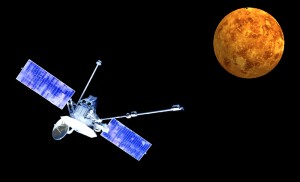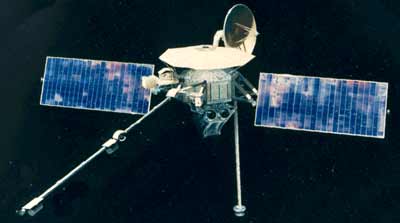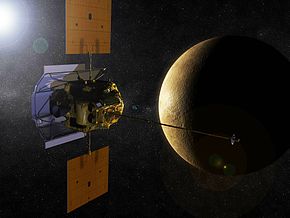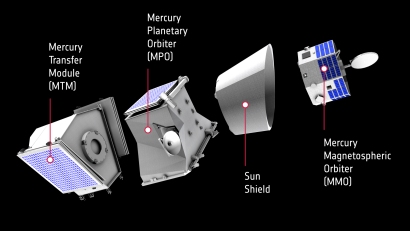Mercury is a special planet. It is the smallest planet in the solar system and the closest to the sun. For most of human history, Mercury remained a mystery. The only knowledge about it came from inferences made by the ancient astronomers after observing the planet from Earth.

- Mariner 10 and Mercury Image Source
Even today, it is probably the least explored of the inner planets with only two spacecrafts having made close observation so far and the third one planned to launch in the near future. This is because Mercury is not an easy to explore planet.
Its close proximity to the sun makes it hard to send spacecrafts to it because it takes an extremely large amount of energy to overcome the sun’s strong gravitational pull and acquire an orbit around Mercury. The sun’s gravity also makes it hard to obtain a satellite orbit.
There has never been a landing mission to Mercury because this planet has no atmosphere. A landing mission would be extremely costly as the use of aerobraking or parachuting to land would be impossible without an atmosphere.
Here, we will explore the only three Mercury exploration missions there have been so far. One is in the past, the second one is ongoing, and the third one is set to launch in the near future.
Past Mission To Mercury: Mariner 10 Mission to Mercury

- Mariner 10 Spacecraft Image Source
Mariner 10 was NASA’s robotic space probe that flew by Mercury and Venus. It was the seventh successful launch in the Mariner series of spacecrafts.
Its objectives were to study the surface and physical characteristics of Mercury, measure its atmosphere and space environment, capture close up images of the planet and provide experience of dual-planet gravity assist.
There were cameras, a magnetometer, a celestial mechanics and radio science, spectrometers, an IR radiometer, scanning electrostatic analyzer and an energetic particle experiment on the spacecraft to collect data and conduct experiments to achieve the mission objectives.
Mariner 10 Launch to Mercury
Mariner 10 was launched on November 3 1973 and arrived to its destination on March 29 1974.
Mercury’s close distance to the sun makes it hard for a spacecraft to acquire an orbit around Mercury directly. To overcome this challenge, Mariner 10 orbited the sun and then flew by Venus for gravity assist to accelerate and reach Mercury.
Mariner 10 made three flybys of Mercury capturing images and data and transmitting these to earth. It passed close to Mercury on March 29 1974 as it flew towards the sun and made the first close range observation of Mercury. It passed close by Mercury two more times before it completing the mission.
The mission ended as a success in 1975 when the spacecraft ran out of fuel and contact with it was lost.
Mariner 10 Accomplishments and Findings
Mariner 10 had many firsts. It was the first spacecraft to visit and study Mercury making NASA the pioneer in the exploration of the planet. It remained the only visit to Mercury for more than 30 years.
Mariner was the first spacecraft to visit more than one planet. It was the first spacecraft to make multiple flybys of a planet and the first ever to use the solar wind to achieve orientation during flight.
It became the first spacecraft to visit two planets and use the gravitational pull of one planet to reach the other, accomplishing one of its objectives to gain experience on gravity assist.
Mariner 10 made the first close up observation of Mercury and captured the first ever close up images of this planet. By studying this data and images, we have learnt a lot about the history and composition of Mercury.
During its mission, Mariner 10 transmitted about 10,000 images of Mercury. The only downside is that the same side of Mercury was always illuminated and it only managed to image just about half of the planet’s surface during the three flybys.
Mariner 10 found that Mercury had survived a near planet collision early in its life. This event made it develop a large iron-nickel core that accounts for 80% of the planet’s mass.
It also showed the surface of Mercury is highly cratered possibly as a result of exposure to impacts and collisions. However, it has not undergone significant crustal modification.
It also measured Mercury’s temperature and found that it ranges from 187°C during the day to -183°C during the night.
Thanks to this mission, we also know that Mercury has a small magnetic field that is very similar to what we have on Earth but it done not have an atmosphere of any kind.
While Mariner 10 findings provided answers to most of the questions we had about Mercury, it also left us with even more questions that the MESSENGER mission that followed was supposed to address.
Present Mission to Mercury: MESSENGER

- An Artists Impression of MESSENGER Orbiting Mercury Image Source
MESSENGER is NASA’s space probe orbiting Mercury. It is NASA’s second mission to Mercury after Mariner 10 and was the first spacecraft to arrive on Mercury thirty years after the first visit. This mission is named after a Roman god but the term is also an acronym for MErcury Surface, Space ENvironment, GEochemistry and Ranging.
It was designed to study the geological history, density, interior structure, environment, atmosphere, magnetic field, frozen volatiles, surface composition, and materials found around Mercury’s poles. It will also investigate whether the hollows of the craters on Mercury’s surface contain ice.
To accomplish its mission, the probe is equipped with innovative instruments to study the composition, structure, and morphology of Mercury and its space environment. Some of the instruments onboard include imaging cameras, spectrometers, laser altimeter, magnetometer, and radio science instruments.
In comparison to the previous Mariner 10, MESSENGER has improved sensors, and high-resolution instruments. It will be able to resolve more features and capture more details of Mercury.
MESSENGER Rocket Launch
MESSENGER launched on August 3, 2004 from Cape Canaveral and made the first flyby of Mercury on January 14 2008, more than six years after its launch.
It first flew past earth and used the Earth’s gravity pull to achieve trajectory to reach Venus. It then used the gravity force of Venus to reach Mercury.
On its orbit around Mercury, the spacecraft follows an extremely inclined mapping orbit with a closest approach of 200km and a farthest distance of about 15000km. This orbit is beneficial in that it ensures the thermal stability of the spacecraft.
The nominal orbital mission was one year but it was extended. The mission is currently ongoing and will end when the spacecraft runs out of fuel.
MESSENGER Spacecraft
Since mercury is very close to the sun, the MESSENGER spacecraft has a special design to protect it from the extremely hot sunlight.
The exterior of the entire spacecraft is covered by a lightweight sunscreen material in order to shield the science payload from the extreme heat and provide a safe temperature to keep the instruments onboard in operating condition.
The instruments are powered by solar energy captured by special solar panels built to withstand the glare caused by intense sunlight given the spacecraft’s proximity to the sun.
To ensure autonomous operation when the spacecraft is out of direct contact with Earth, which occurs when Mercury is at the far side of the sun in its orbit, there are advanced computers onboard capable of autonomous operation.
MESSENGER Findings and Accomplishments
MESSENGER was the first spacecraft to orbit Mercury. This mission has led to plenty of discoveries about Mercury, some of which are a total surprise.
Before it acquired orbit around Mercury, it made a series of flybys discovering a lot of new things about this planet. It even managed to image the other side of Mercury that was hidden during all the three Mariner 10 flybys.
One of Messenger’s discoveries about Mercury is that the planet has a complex internal structure. Its core accounts for 85% of the planet’s radius. This is surprising given the planet’s size. Close observation of the core by MESSENGER’S instruments showed that this core is part liquid. Scientists were surprised because they expected a planet as small as Mercury to have a solid core.
For decades, scientists had wondered whether there were volcanic deposits on the surface of Mercury. MESSENGER captured images showing volcanic vents and ridges formed by the lava after eruption.
For years, there were speculations that there were water ice and frozen volatile materials in Mercury’s polar carters that are sheltered from the sun. In November 2012, MESSENGER found new evidence proving the existence of water ice at Mercury’s poles.
MESSENGER’s images and data show that the planet has a unique and diverse geology. It also revealed Mercury’s magnetosphere to be different from the one shown by Mariner 10.
Future Exploration Missions to Mercury: BepiColombo Mission
BepiColombo is a future mission to Mercury that is currently in the planning and development stage. It is a joint mission by the European Space Agency (ESA) and Japan Aerospace Exploration Agency (JAXA). It will be the first mission by Europe and Japan to visit the innermost region of our solar system and the third mission to Mercury.
The mission is named after Professor Giuseppe Bepi Colombo, an Italian physicist, who pioneered the studies of the complex dynamics of Mercury’s orbit around the sun and its rotational period and suggested the use of the gravity assist technique during the Mariner 10 mission.
The mission’s objectives are quite similar to the previous missions’ objectives but it will take a more in depth look. It will investigate Mercury’s high density, mysterious core, tectonic activity, magnetic field, exosphere, aurora, radiation belts, form, interior structure, presence of iron, composition of craters located in the Polar Regions, magnetospheric substorms, and test the general relativity theory. It will also look for asteroids near the sun and investigate the origin and evolution of a planet that is close to its parent star.
BepiColombo Spacecraft

BepiColombo spacecraft will have two separable components developed by the two agencies: ESA’S Mercury Planetary Orbiter (MPO) and JAXA’s Mercury Magnetospheric Orbiter (MMO). It would have been a very ambitious mission with a planetary lander included but this was abandoned due to financial constraints.
The MPO will be equipped with wide angle and narrow angle cameras, infrared spectrometer, gamma, X-ray and neutron spectrometers, laser altimeter, near Earth Object telescope, and detection system and radio science instruments. It will enter a 400 by 1500 km polar orbit that is close to the planet to capture quality close up images of Mercury and study its surface and internal composition. It will apply unique design features and novel insulation materials to maintain its thermal stability.
The MMO will have an imaging system, wave receiver, positive ion emitter, fluxgate magnetometers and charged particle detectors. It will enter a highly elliptical orbit around Mercury and is intended to collect data over a large part of Mercury’s magnetic field and find out how this field interacts with the solar winds.
The two orbiters will also investigate the existence of water ice in the hollows of carters found in Mercury’s shadowed regions.
BepiColombo Launch
BepiColombo is scheduled to launch in July 2014 and enter Mercury’s orbit around January 2022. It will take the powerful Ariane 5 rocket to launch it since it is very heavy weighing 2.3 tonnes at liftoff. It is planned to remain in orbit for 1-2 years.
It will also face the same challenge faced by the previous spacecrafts and will have to use the gravity of Earth and Venus as well as solar electric propulsion to slow down the spacecraft as it approaches Mercury.
After entering its path to Mercury, it will apply an innovative ion propulsion system known as SEPM, which uses a beam of xenon ions accelerated to very high speed to provide thrust. The use of this engine system will reduce the flight period to only 2.5 years including flybys of Venus and Mercury.
On arrival to Mercury the SEPM engine will be discarded and a standard chemical rocket will insert the spacecraft into orbit around Mercury.
Once in orbit, the spacecraft will begin its year long mission to map the surface of the planet, study the space environment and perform unique experiments.
What is Unique about the BepiColombo Mission?
BepiColombo mission is designed to complement the findings by Messenger. It is more sophisticated, will follow different orbital paths, will conduct more measurements and collect a wider range of data than MESSENGER.
This mission is more ambitious than the two previous exploration missions to Mercury and will conduct some unique experiments that have not been conducted in the previous missions. It intends to capture the first ever images of Mercury’s surface and collect data from the surface.
To accomplish this unique investigation, the spacecraft is equipped with a pair of surface lander with penetrators that will drop on the surface near the North Pole. The penetrators have a camera, analytical instruments and seismometers that will collect data and capture images of the surface of this planet.
Apart from unlocking more secrets about Mercury, these studies will also enable use to learn more about the formation of the solar system and especially the formation of the innermost planets.
